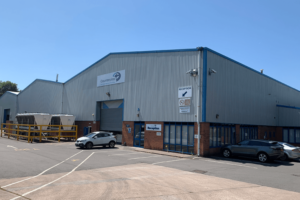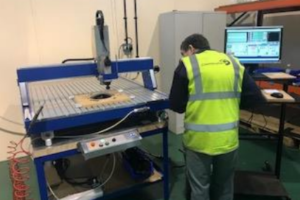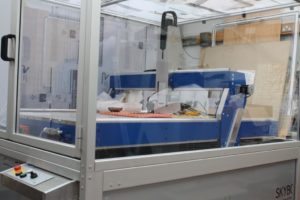September 27, 2016

No Flow Temperature: No flow temperature is the temperature at which the viscosity of the melt is so high that it effectively cannot be made to flow.
Orientation: Orientation is the change in shape that polymer molecules can undergo when they are made to flow.
Parting Line: Contour line on the part separating core and cavity.
Polymer: Long chains of covalently bonded atoms.
Pressure Drop: Pressure drop is the loss of pressure that occurs when the melt is pushed into a section of the mould during the filling phase.
Pressure Profile: After switchover point injection speed should remain at lower value and pressure is changed with time until the mould is just filled without over-packing. This follow up/hold on pressure change with respect to time is called Injection pressure profile.
pvT diagram: Polymer Melt follows law similar to famous gas law (Boyle’s law). It is the relationship between pressure, volume and temperature for plastic melt.
RAPRA: RAPRA technology Ltd (UK) is a leading rubber and plastics consultancy firm with over 75 years of experience. They offer conduct training courses in Rubber and Plastics.
Repeatability: Repeatability is closeness of agreement of a tool movement position from one part to another when cutting several copies of the same part.
Residence Time: Residence time is the length of time that the material is held at melt range temperatures in the barrel.
Residual Stress/Moulded-in Stress: Residual stress is a term that describes the level and pattern of stress, which is left in the part after it is removed from the machine. It can be due to unbalanced flow, non-uniform freezing of melt, and over packing.
Runner Layout: It is the channels used to get the melt from the machine nozzle to the gates.
Shear Heating: Shear heating is due to friction caused by flow of melt through narrow passages in the mould during filling phase.
Shear Rate: Shear rate is a way to describe how quickly the velocity of the melt changes from the mould surface to the centre of flow for a given cross section. The size of the shear rate gives an indication of the shape of the velocity profile for a given situation.
Shear stress: Shear stress is the result of the force that is generated in a melt to overcome its resistance to a particular flow situation. Shear stress is the product of a material and shear rate.
Shear Thinning: Shear thinning is the description for the physical effects of orientation and affect the flow behavior of the polymer. Shear thinning causes the melts viscosity to drop when it is made to flow within a certain shear rate range.
Shot Composition: The shot size setting and the switchover point give the machine information about how the melt has to be injected into the mould. The stroke positions correspond to volumes of melt that play a role in different portions of the moulding cycle. While the settings relate to the machine barrel, they correspond with the actual events that happen during the cycle.
Shot size Setting: Shot size setting is a control setting which limit how far back the screw will travel as it rotates in the cooling phase of the cycle. The shot size setting is measured as a distance from the front of the barrel.
Shrinkage: It is the deviation of dimensions of the moulded part from the dimensions of cavity when measured on moulded part after certain hours. Compressibility, thermal expansion and pvT characteristics influence the dimensions of moulded part.
Sink Mark: A depression on the surface of moulded part caused by differential shrinkage.
Specific Heat: Temperature is measure of heat energy level whereas heat is a measure of total internal energy contained in a body. When the same quantity of heat is given to equal masses of different substances, they do not result in the same rise in temperature. The specific heat is defined as the quantity of heat energy which will rise the temperature of unit mass (1kg) of a substance by 1°C. Heat = mass x specific heat x Temperature rise.
Specific Volume: It is inverse of density. It is volume per unit weight. Unit is cc/gr.
Speed profile: Injection speed setup with respect to stroke positions for the filling phase so that melt front speed remains near constant during filling phase.
Split Points: Split points are locations in a mould cavity where a melt front will split up and advance in more than one direction at the same time. It is also referred as flow junctions, branch points, or nodes.
Stress Cracking: A crack, either external / internal, in a plastic part caused by tensile stress less than its short time mechanical strength.
The moulded-in stress left in the moulded part – due to unbalanced filling, over packing or non-uniform freezing – can fail in service condition. The service environment can have objectionable temperature or contact with aggressive chemicals causing the plastic part to fail. Avoiding or minimising moulded-in stress in plastic part can increase the performance of part even under adverse condition.
Switch over point fill to pack: The point on injection stroke at which filling phase with speed profile ends and pack or pressure phase with pressure profile starts.
Thermal Stability: It is polymers thermal characteristic. It is the time interval for which polymer remains stable at certain temperature. Beyond that time if the polymer is exposed to longer duration for a given temperature, it degrades.
Thermoplastic: Linear plastics of finite molecular weight that can be fabricated in a complex shape by melting and injection moulding.
Thermoset: A type of plastics that must be cured, forming network like structures that do not soften at high temperature.
Vulcanisation: A process by which a network of cross linking is introduced into an elastomer to strengthen it.
Viscosity response: The viscosity response is a way of describing how the viscosity of a particular polymer responds to the changes in temperature and shear rate.
Warpage: Uneven bending, Twisting etc. on account of differential cooling, differential shrinkage, or non-uniform freezing of melt in the mould can cause these conditions in the moulded part.
Weld Lines: Weld lines are locations in the moulded part where two met fronts meet.
Wireframe: It is a geometric model that describes 3D geometry by outlining its edges.
Work Done: Work is said to be done if an unbalanced force moves its point of application through a distance measured in the direction of force. Work = Force x Distance.
If you have any questions relating to the above glossary then contact Pete with your question.
PS Did you miss the first part? Here’s Pete’s A-M glossary

July 04th, 2019
Leading technical injection moulder, Counterplas, has set ambitious growth targets, buoyed by their recent move to a large new facility in South Staffordshire.

February 02th, 2018
Counterplas have invested in the latest Rhino version 5 software, widely acclaimed as the world’s most robust 3-D development platform for specialty modelling, rendering, analysis, and fabrication tools.

January 08th, 2018
We have invested in a new CNC routing system for production of illuminated bespoke street furniture for a new client in Germany. A ‘blank’ is injection moulded and then routed to provide one of 270 variants.